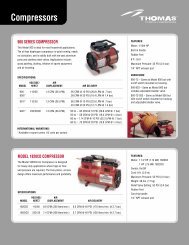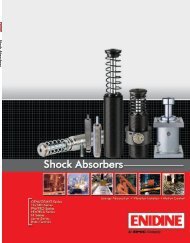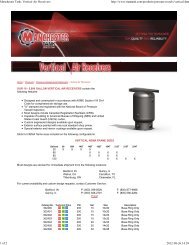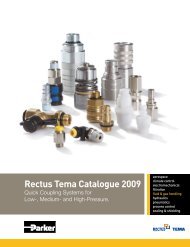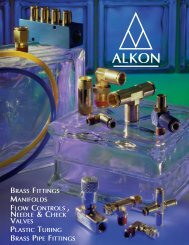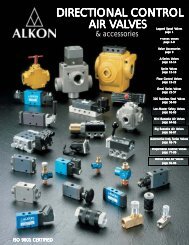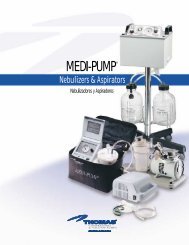Contents Norgren Pneumatic Valve Products
Contents Norgren Pneumatic Valve Products
Contents Norgren Pneumatic Valve Products
Create successful ePaper yourself
Turn your PDF publications into a flip-book with our unique Google optimized e-Paper software.
Helpful Engineering Information<br />
Determining Proper Air <strong>Valve</strong> Size<br />
Most manufacturers catalogs give flow rating Cv for the valve, which was<br />
established using proposed National Fluid Power Association (NFPA)<br />
standard T3.21.3. The following tables and formulas will enable you to<br />
quickly size a valve properly. The traditional, often used, approach of<br />
using the valve size equivalent to the port in the cylinder can be very<br />
costly. Cylinder speed, not port size, should be the determining factor.<br />
The following Cv calculations are based upon simplified formulas which<br />
yield results with acceptable accuracy under the following standard<br />
condition:<br />
Air at a temperature of 68°F (20°C)<br />
Absolute downstream or secondary pressure must be 53% of absolute<br />
inlet or primary pressure or greater. Below 53%, the air velocity may<br />
become sonic and the Cv formula does not apply. To calculate air flow to<br />
atmosphere, enter outlet pressure p 2 as 53% of absolute p 2 . Pressure<br />
drop ∆ P would be 47% of absolute inlet pressure. These valves have<br />
been calculated for a Cv = 1 in Table 3.<br />
Nomenclature<br />
B Pressure drop factor<br />
C Compression factor<br />
Cv Flow factor<br />
D Cylinder Diameter (IN)<br />
F Cylinder Area (SQ IN)<br />
L Cylinder Stroke (IN)<br />
p 1 Inlet or Primary Pressure (PSIG)<br />
p 2 Outlet or Secondary Pressure (PSIG)<br />
∆ P Pressure differential (p 1 - p 2 ) (PSID)<br />
q Air flow at actual condition (CFM)<br />
Q Air flow of free air (SCFM)<br />
t Time to complete one cylinder stroke (SEC)<br />
T Absolute temperature at operating pressure<br />
Deg R = Deg F + 460<br />
(R°)<br />
<strong>Valve</strong> Sizing for Cylinder Actuation – (Method A)<br />
C v =<br />
cylinder area<br />
(Sq In) cylinder stroke Compression factor<br />
(see Table 1) F x (IN) L x (see Table 2) C<br />
Pressure drop time to complete<br />
factor B x cylinder stroke t x 29<br />
(See Table 2) (SEC)<br />
Example:<br />
Cylinder size 4" Dia. x 10" stroke. Time to extend: 2 seconds. Inlet<br />
pressure 90 psig. Allowable pressure drop 5 psid. Determine Cv.<br />
It is considered good engineering practice to limit<br />
the pressure drop ∆ P to approximately 10% of<br />
primary pressure p 1 . The smaller the allowable<br />
pressure drop, the larger the required valve will<br />
become.<br />
After the minimum required Cv has been calculated,<br />
the proper size valve can be selected from the<br />
catalog.<br />
Bore Size Push Bore Bore Size Push Bore<br />
D (in) F (sq in) D (in) F (sq in)<br />
3/4" .44 4" 12.57<br />
1" .79 4-1/2" 15.90<br />
1-1/8" .99 5" 19.64<br />
1-1/4" 1.23 6" 28.27<br />
1-1/2" 1.77 7" 38.48<br />
1-3/4" 2.41 8" 50.27<br />
2" 3.14 10" 78.54<br />
2-1/2" 4.91 12" 113.10<br />
3-1/4" 8.30 14" 153.94<br />
Table 1: Cylinder push bore area F for standard size<br />
cylinders<br />
Inlet Compression Pressure Drop Factor B<br />
Pressure Factor for various Pressure Drops ∆ P<br />
(psig) C 2 psig 5 psid 10 psid 15 psid 20 psid<br />
10 1.7 6.5<br />
20 2.4 7.8 11.8<br />
30 3.0 8.9 13.6 18.0<br />
40 3.7 9.9 15.3 20.5 23.6<br />
50 4.4 10.8 16.7 22.6 26.4 29.0<br />
60 5.1 11.7 18.1 24.6 29.0 32.0<br />
70 5.8 12.5 19.3 26.5 31.3 34.8<br />
80 6.4 13.2 20.5 28.2 33.5 37.4<br />
90 7.1 13.9 21.6 29.8 35.5 39.9<br />
100 7.8 14.5 22.7 31.3 37.4 42.1<br />
110 8.5 15.2 23.7 32.8 39.3 44.3<br />
120 9.2 15.8 24.7 34.2 41.0 46.4<br />
130 9.8 16.4 25.6 35.5 42.7 48.4<br />
140 10.5 16.9 26.5 36.8 44.3 50.3<br />
150 11.2 17.5 27.4 38.1 45.9 52.1<br />
160 11.9 18.0 28.2 39.3 47.4 53.9<br />
170 12.6 18.5 29.0 40.5 48.9 55.6<br />
180 13.2 19.0 29.8 41.6 50.3 57.2<br />
190 13.9 19.5 30.6 42.7 51.7 58.9<br />
200 14.6 20.0 31.4 43.8 53.0 60.4<br />
210 15.3 20.4 32.1 44.9 54.3 62.0<br />
220 16.0 20.9 32.8 45.9 55.6 63.5<br />
230 16.7 21.3 33.5 46.9 56.8 64.9<br />
240 17.3 21.8 34.2 47.9 58.1 66.3<br />
250 18.0 22.2 34.9 48.9 59.3 67.7<br />
Table 2: Compression Factor C and pressure drop<br />
Factor B.<br />
Solution: Table 1 F = 12.57 sq in<br />
Table 2 C = 7.1<br />
B = 21.6<br />
Cv = 12.57 x 10 x 7.1 = .7<br />
21.6 x 2 x 29<br />
Select a valve that has a Cv factor of .7 or higher. In most cases a 1/4"<br />
valve would be sufficient.<br />
VAL-13-6 Littleton, CO USA Phone: 303-794-2611 www.norgren.com



